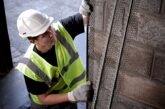
I have watched the development of Speedskim over several years. Like all good inventions it has evolved and, along the way, it has also created a lot of lively debate.
Plasterers are an interesting breed, they defend their craft and traditional practices with a passion and I admire them for that. There are those who see Speedskim as the devil’s work, a direct attack on the supremacy of the trowel, and there are those who wouldn’t be without it.
The first thing to acknowledge is that you still have to put the plaster on the wall or ceiling and for most that remains the domain of the hawk (handboard) and trowel (float) and it is where most of the hard work is.
However as soon as the plaster is on you can run across the surface with the Speedskim to flatten it. This is such a quick and more accurate process than a trowel and it will save you a significant amount of time and effort.
![]() Once you have made a pass each way on the wall or ceiling it will have taken off the high spots and, to a certain extent, filled in the hollows.
Once you have made a pass each way on the wall or ceiling it will have taken off the high spots and, to a certain extent, filled in the hollows.
It really depends on the angle you hold it at. If you hold it at 90 degrees it will take material off in the same way as a feather-edge but if you hold it at 45 degrees or even flatter it will lay the material down. This is achieved by a row of small ribs on the blade that helps limit the amount of material that moves up towards the handle.
There are those who worry about the fine lines created by the corners of the blade, you can round the blade off slightly, which helps, but the best way is to just tidy the surface up with a trowel.
For some Speedskim is a tool for flattening and straightening and for others it is a tool that can also be used for finishing. If you are going to finish with it then I would recommend a pump up spray bottle to wet the surface. That will prevent any juddering.
You can buy the Speedskim in three different lengths 600, 1,200 and 1,800mm. Most people tend to buy a set but if your main aim is to flatten ceilings I would suggest that the 1,800 is a bit too wide to use on the pole. In fact I know some people who use the 600 on the pole, claiming that they get much better pressure and control.
Having used the Speedskim for a few weeks now I am persuaded that it has its place.
Certainly for me, a plumber who does a bit of plastering, it is a great help. It allows me to flatten walls after hacking off tiles and when I say flat I mean flat.
All too often I have had plasterers in to do this job and found that I am still having to make up tile beds to overcome their sweeping curves. The chief gripe for me is the way that they ramp up into the corners. With the Speedskim this is rectified immediately.
The same goes for the ceiling line and it is pure joy on up and over skeiling (sic) sweeps. I plastered my kitchen and the guys who came to fit the granite worktops were surprised by how straight the walls were. I asked them if it was unusual and they said it is rare for them to be able to fit straight to the wall.
Notwithstanding my success with the tool, I know plasterers who have bought Speedskims and gone into rages of frustration because they can’t get the hang of them.
![]() In that respect it may be easier to get a non-plasterer up to speed than an old hand but it is the older guys who are suffering with repetitive strain injury from years on the trowel who will benefit the most.
In that respect it may be easier to get a non-plasterer up to speed than an old hand but it is the older guys who are suffering with repetitive strain injury from years on the trowel who will benefit the most.
It won’t get the plaster on the wall or ceiling and it may not give you the final polish but it could save you 500 sweeps of the trowel in a day and that has got to give your wrist a rest.
That figure of 500 is entirely a guess by the way. I have never counted how many movements of the trowel it takes to flatten a wall or ceiling, it depends how you put it on.
Over the coming months I am going to keep a set of Speedskims in the van and as I travel about the country I will let plasterers give them a try to gather some further impressions.
Certainly my old mate Dave Pederson and his sons are interested in trying it on some big ceilings that they have coming up soon.
They have what you might call a healthy level of scepticism about anything that doesn’t hurt. They believe that work = pain and that is why people pay you to do it.
For more information click here.







